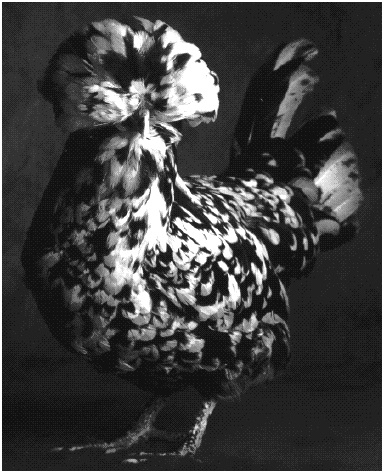The Second Wave
Peter Singer, Editor
(Blackwell Publishing)

In Defense of Animals offers an extended discussion of how this should be applied to animals, suggests that the greatest happiness for the greatest number should apply, equally, to non-humans. Singer calls this "speciesism," urges that you and I should be kinder to those who are close to us on the evolutionary scale, such as bonobos.
- there has been no justification for the moral gulf we impose between ourselves and our evolutionary relations ... [since] many nonhumans can suffer pain and distress in the same sort of ways that humans do.
There are reports "from the field." Matt Ball gives annual figures of the number of animals slaughtered each year in the United States for eating (10,000,000,000), and reports on the living conditions in "factory farms," where we find
- layer hens with open sores, covered with feces, sharing their tiny cage with the decomposing corpses of fellow birds; pigs sodomized with metal poles, beaten with bricks, skinned while still conscious; steers, pigs, and birds desperately struggling on the slaughterhouse floor after their throats are cut.
Finally, we have the activist reports. Miyun Park and friends go on a raid a factory farm in Cecilton, Maryland, run by ISE, awash with 800,000 hens. The vigilantes sneak in at night with video camera to document the "battery cage facility," taking time to liberate eight chickens before they are chased off. "The selected hens we came to call Jane, Rose, Lynn, Petra, Hariet, Christina, Eve and Jackie" end up in various houses and apartments in nearby Washington, D.C.
How they got away with this --- not the kidnappings, Lord knows, but the housing in urban areas --- I'll never understand. Full disclosure requires that I tell you that several years ago I elected to raise chickens in my backyard in what is a very bird-unfriendly, unnamed city in Southern California.
I was informed on by a neighbor. He claimed that Chauntecleer woke him at six a.m. I was raided by the police, my beloved rooster and kindly hen (Chicken Lickin') were denounced as "public nuisances." I was hauled before a magistrate, threatened with a fine, and forced to swear that I would at no time in the near future raise feathery creatures in my back yard.
The big problem with In Defense of Animals comes down to a matter of balance. According to UNESCO, 35,515 children worldwide die of malnutrition every day. That's over thirteen million children --- mostly infants --- dying of hunger every year. For me and most of my friends, speciesism demands that we care for our own: namely, human beings. Chickens, pigs, dogs and cats must come later.
In "Living and Working in Defense of Animals," Matt Ball reveals that PETA (People for the Ethical Treatment of Animals) now has 750,000 members, and "spends millions of dollars trying to improve the treatment of animals in North America and Europe." At the same time, Adam Mynott of BBC news recently reported from Kenya, "When the camels start dying, that's when it's getting bad," says Captain Wachilu, a young Kenyan army officer in charge of the government food distribution in the Wajir region.
- His assessment is impossible to disagree with.
He sends out five trucks a day to different villages dotted across Wajir.
They are loaded with maize, rice, milk-powder and cooking oil.
Every few kilometres alongside the rutted, dusty tracks, the convoy trundles past the carcasses of dead animals.
The bodies of cows, goats and the occasional camel which have succumbed to starvation and heat have been picked at by hyenas and vultures.
Where is PETA?
Mynott continues, "dozens of children have died."
Fifteen of its 20 beds are occupied by malnourished children.
In the past few weeks, six infants have died at the hospital from hunger-related ailments, and some of the some children lying with their mothers in the ward look desperately unwell.
Muslima is 15 months old.
She arrived at the hospital three days ago suffering from vomiting, diarrhoea, dehydration and malnourishment. She weighs just 4.9kg.
In Macoror village, Yunis Mohammed Hassan is looking after three of his children while his wife has taken two others to hospital.
"I used to be a rich man," he said. "I had 160 cattle. Now I have 2. I have no money, no work, my children are sick. What do I do?"
They say that hunger has killed 32 people, mostly children, in their village alone, suggesting that the official figure of 40 deaths so far nationwide could be a gross underestimate.
Where is PETA?
Or to put it more simply --- are we to care for the suffering chickens before we care for our suffering children?